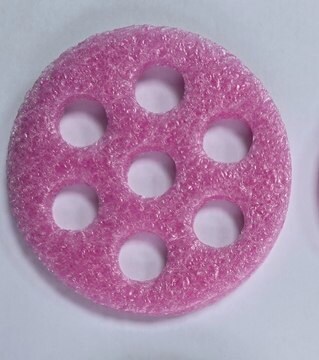Regenerated cellulose membranes are typically compatible with acids and alcohols. Organic solvent compatibility varies from compound to compound. However, the solvent concentration, temperature, and exposure time are factors to be considered. Please see the table below to review the general membrane compatibility with various solvents.
D9652
Tubos de membrana de celulosa para diálisis
avg. flat width 33 mm (1.3 in.)
Sinónimos:
Cellulose Dialysis Tubing, Cellulose Membrane, Dialysis Membrane
Seleccione un Tamaño
156,00 €
Seleccione un Tamaño
About This Item
156,00 €
Productos recomendados
diám. prom.
21 mm , when full
prom. anchura plana
33 mm (1.3 in.)
capacidad
~110 mL/ft
¿Está buscando productos similares? Visita Guía de comparación de productos
Descripción general
Envase
Calidad
Nota de preparación
Código de clase de almacenamiento
13 - Non Combustible Solids
Clase de riesgo para el agua (WGK)
WGK 3
Punto de inflamabilidad (°F)
Not applicable
Punto de inflamabilidad (°C)
Not applicable
Elija entre una de las versiones más recientes:
Certificados de análisis (COA)
Lo sentimos, en este momento no disponemos de COAs para este producto en línea.
Si necesita más asistencia, póngase en contacto con Atención al cliente
¿Ya tiene este producto?
Encuentre la documentación para los productos que ha comprado recientemente en la Biblioteca de documentos.
Los clientes también vieron
Contenido relacionado
Dialysis Tubing
-
Which organic solvents can be used with these membranes?
1 respuesta-
¿Le ha resultado útil?
-
-
how do I prepare the tubings before usage?
1 respuesta-
Instructions have been provided in the 'Preparation Note' in the 'DESCRIPTION' section.
-Wash the tubing in running water for 3-4 hours to remove glycerol included as a humectant.
-Treat the tubing with a 0.3% (w/v) solution of sodium sulfide at 80°C for 1 minute to remove sulfur compounds.
-Wash with hot water (60°C) for 2 minutes, followed by acidification with a 0.2% (v/v) solution of sulfuric acid, then rinse with hot water to remove the acid.
This tubing will retain most proteins of molecular weight 12,000 or greater.¿Le ha resultado útil?
-
Filtros activos
Nuestro equipo de científicos tiene experiencia en todas las áreas de investigación: Ciencias de la vida, Ciencia de los materiales, Síntesis química, Cromatografía, Analítica y muchas otras.
Póngase en contacto con el Servicio técnico






